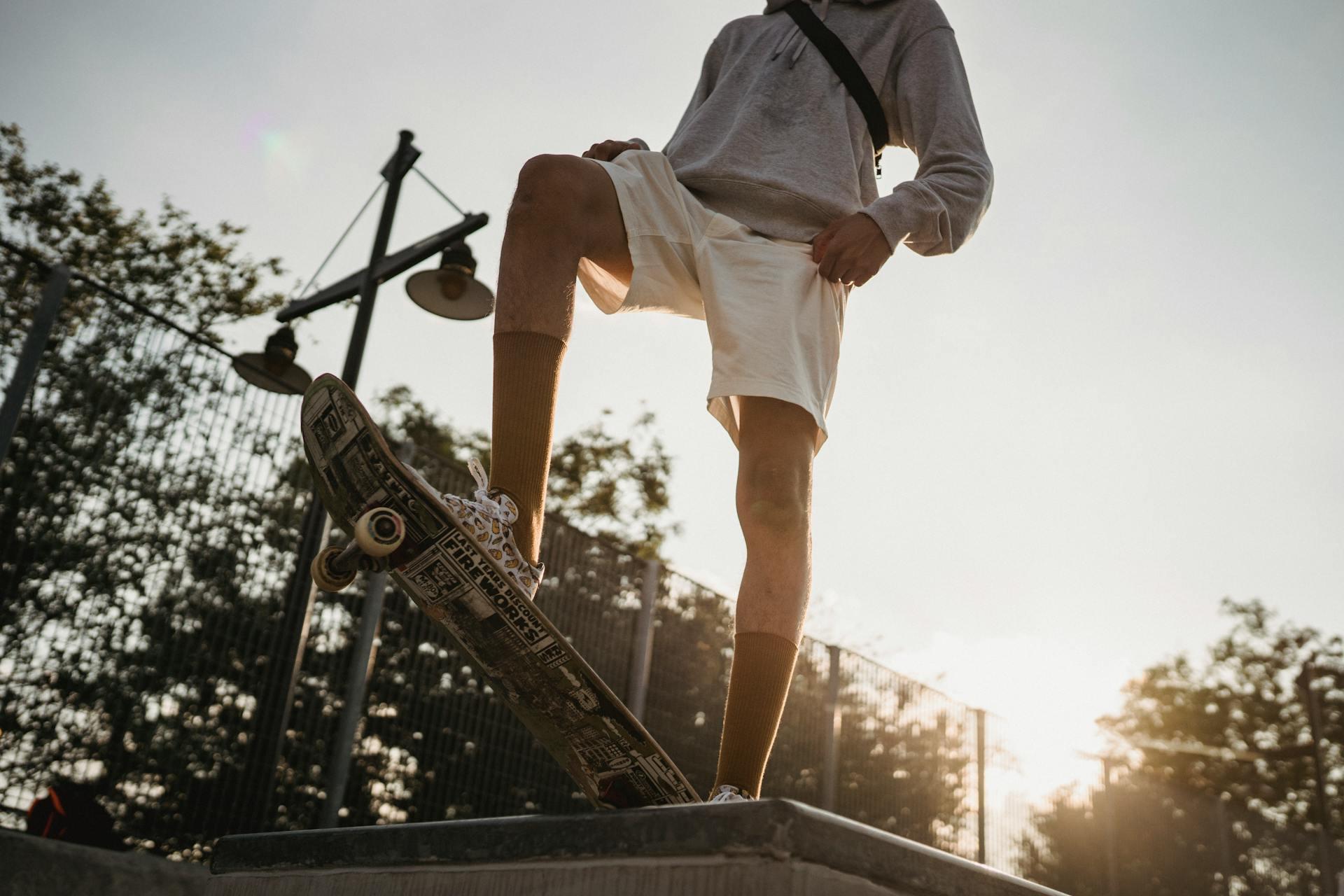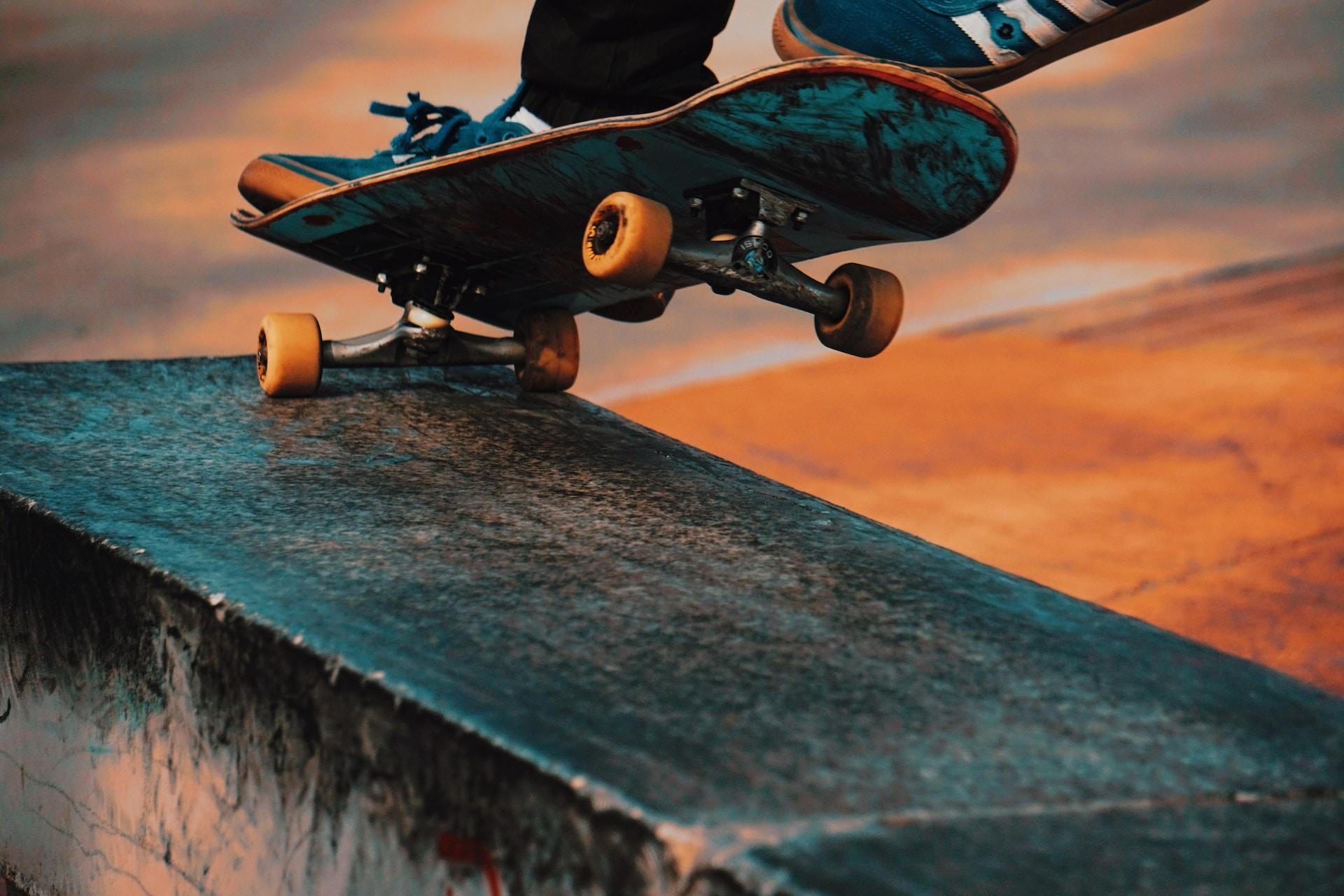Skateboarding is a thrilling blend of athleticism, creativity, and freedom. It's a fantastic sport or hobby for people of all ages and abilities with a welcoming community.
This guide will teach you everything from choosing the right gear to mastering skateboarding fundamentals and learning amazing tricks. Get ready to learn how to ride a skateboard for beginners!

Before You Board: Skateboarding Safety Gear
Before you hop on a skateboard for the first time, you should know how to protect yourself from the inherent risks of the sport. By nature, skateboarding can be pretty dangerous, so it’s important to protect yourself as best as possible.
Wear protective gear to avoid injuries like brain damage, broken bones, and scrapes while learning to skateboard. With the right protection, you have a safety net for the inevitable falls that come with mastering the sport. This allows you to confidently approach skateboarding, knowing that falls are unlikely to require a hospital visit.
Be sure to equip the following before you board:
- Well-fitting skateboard helmet, free of cracks
- Well-fitting knee and elbow pads
- Wrist guards
- Proper shoes that can grip the board, with no dangling laces
With these basic protective items, plus your well-maintained skateboard, you’re ready to start learning!
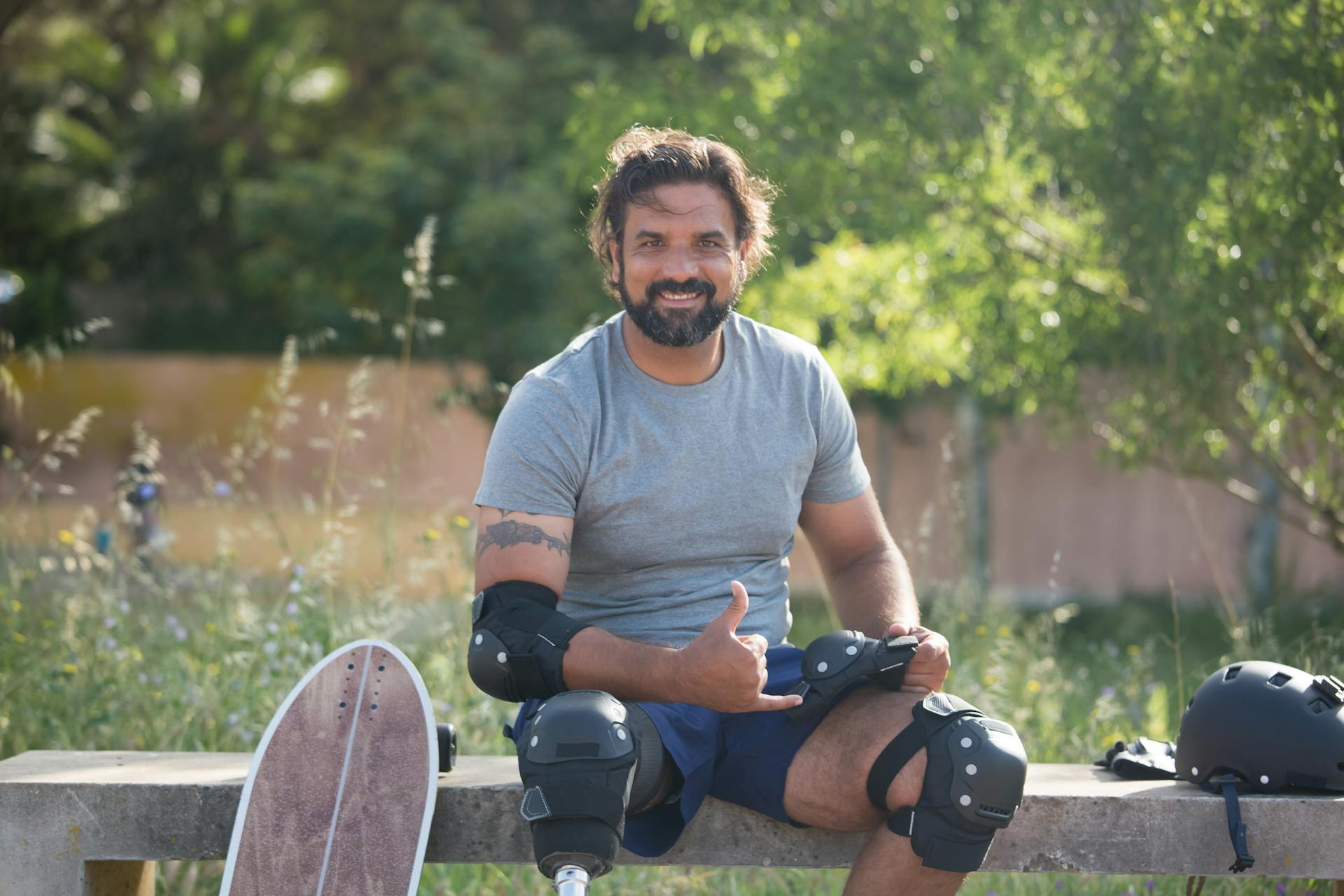
Skateboard Basics: How to Skateboard for Beginners
To become a confident skateboarder, start by mastering the fundamentals. Before attempting tricks or cruising around, focus on learning the basic skills of riding a skateboard. Mastering the basics is key before moving on to more advanced maneuvers.
Balancing on a Skateboard
Before you do anything else on your board, you must learn how to balance. Without this solid foundation, even the simplest maneuvers will be daunting, so it’s important to learn how to stand on a skateboard and find your balance.
- Stance and Weight Distribution: Maintaining a proper stance is crucial for achieving balance. Keep your knees gently bent, your back straight, and your weight evenly distributed between your front and back feet. Avoid leaning too far forward or backward which can compromise your stability.
- Foot Positioning: Your foot positioning is essential for balance, stability, pushing, and eventually, executing tricks. Ensure that your feet are both perpendicular to the board, with the front toes angled slightly toward the nose. Your feet should be about shoulder-width apart, with your back foot on the back bolts and your front foot on or just behind the front bolts.
- Center of Gravity: Understanding your center of gravity is key to balancing on a skateboard. By keeping your body low (but not too low!) and your weight centered over the board, you'll be able to respond quickly to any shifts or movements, minimizing the risk of losing your balance.
You can increase your sense of balance off the board by practicing simple exercises like standing on one foot, calf raises, toe stretches, and standing yoga poses.
Here is how you can progress from nothing to centered on your board:
- Start with your board on the grass so it won’t roll. Practice getting your stance and foot placement down so it becomes second nature. Determine if your stance is goofy or regular.
- Put your board on a smooth, flat surface and simply stand on it, keeping your balance as it rolls slightly back and forth.
- Use a chair, fence, wall, or other support to gently push yourself forward without moving your feet, so you get more used to movement.
- Without support, step on the board and practice keeping balance while it rolls.
- Practice the motion of pushing (may need to go back to the grass for a while). Your front foot needs to turn so the toes face forward and the back foot pushes against the ground. When the back foot comes back onto the board, the front foot goes back to its regular position.
- Begin pushing at slow speeds so you can easily jump off your board to stop.
With time and repetition, you will be a pro at balancing!
How to Stop on a Skateboard
The next most important thing to learn is how to stop properly and fall safely. You can’t always just jump off your board! Here are a few basic ways to stop your skateboard.
- Foot Braking: This is one of the most fundamental stopping techniques. As you approach your desired stopping point, gently drag your back foot on the ground beside the board. Apply gradual pressure to create friction and slow your momentum.
- Bail Technique: In certain situations, the safest option may be to bail off the board altogether. If you find yourself in a precarious situation or unable to stop in time, it's better to step off the board and regain your footing than risk a potential fall or collision. Practice running off the board in a controlled manner, keeping your body low, and distributing your weight evenly.
Also, practice falling and rolling. Whether intentionally bailing or wiping out, knowing how to fall roll forward, sideways, and backward is vital for injury prevention. - Tail/Heel Sliding: These techniques should be used sparingly because they wear down your board and shoes quickly, and can create a dangerous sharp edge on your board. Press down on the tail of your board so it and/or the heel of your shoe drag on the ground.
- Pop-up: This is a simple trick. As you step off your board while in motion (not going too fast!), press the tail down so the nose lifts up and you can catch the board.
You’ll need to learn these techniques alongside acceleration since you can’t have one without the other. When you get more advanced, you can start practicing powersliding to stop!
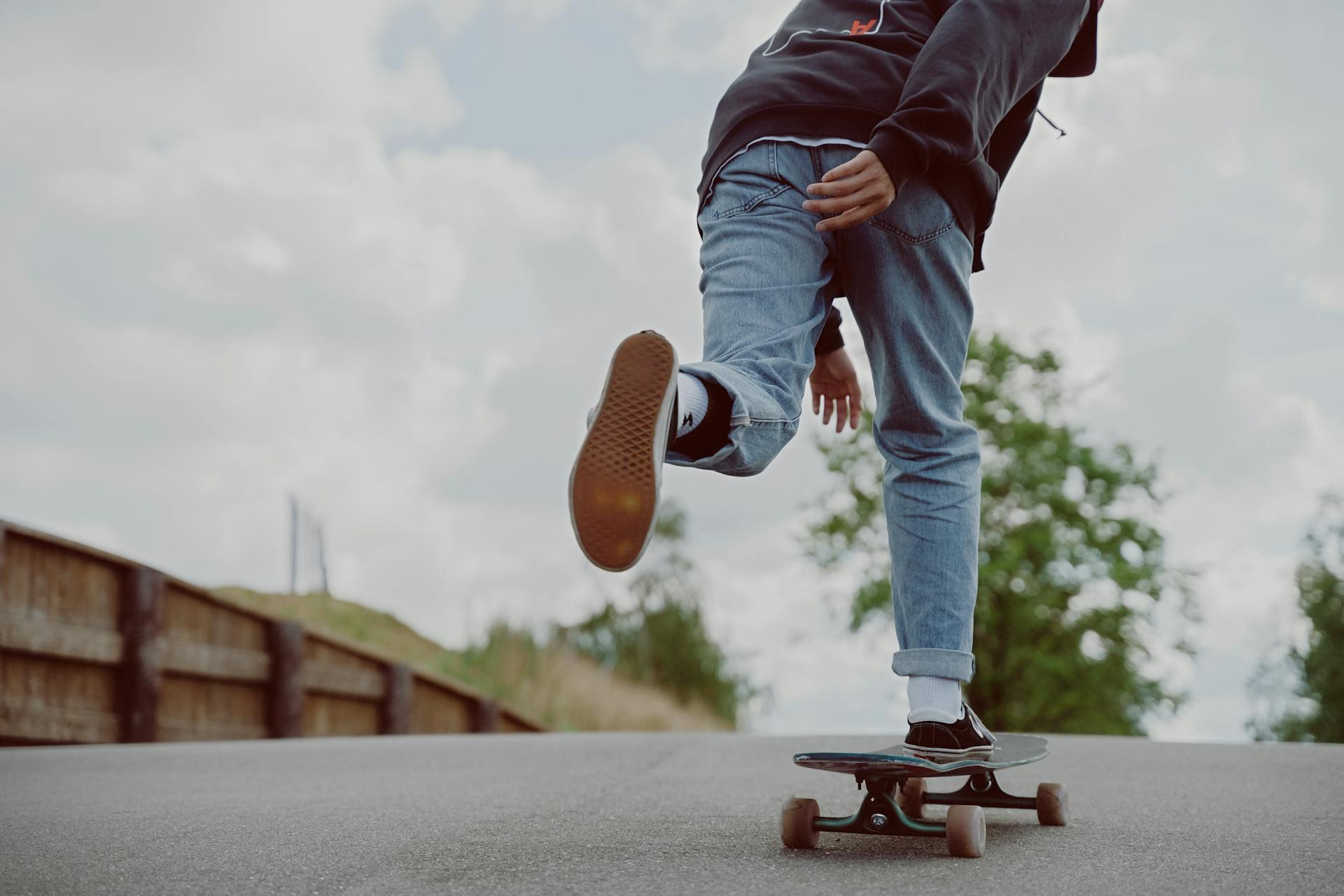
How to Accelerate on a Skateboard
Of course, you’ll definitely want to learn how to go forward and speed up on your board! Many maneuvers are actually easier at a moderate speed, so learning how to pick up the pace is vital for practicing your balance, stopping, turning, and tricks.
- Pushing Technique: The most common method of acceleration is the push technique. Start by placing your front foot on or just behind the front bolts, with toes facing the nose. Use your back foot to push against the ground a few times to generate momentum. Practice your positioning as you switch from pushing to riding and back. Be careful not to push with the front foot by accident (which is called pushing “mongo”).
- Tic-tac Technique: This useful trick is essentially using small, consecutive kickturns back and forth to generate momentum. It’s a great way to enhance your balance and board control skills and gain speed without removing your feet from the deck.
- Carving: You can also sometimes generate momentum just by carving!
Remember, acceleration is a skill that requires practice and coordination. Start slowly, focusing on developing a smooth and controlled pushing motion. As you gain confidence, gradually increase your speed.
How to Turn on a Skateboard
The final fundamental skill is learning how to turn. There are a few different basic ways you should know before you move on to more advanced techniques.
- Carving Technique: This is a good method for gradual turns. Shift your weight to your toes or heels to turn left or right. Be sure to maintain a good stance and balance!
- Kickturn Technique: Use your back foot and ankle to quickly press into the tail of the skateboard, lifting the nose for a moment. At that moment, twist your body to turn the front of the board left or right. When the nose comes back down, you’ll be going in a new direction.
Your shoulder positioning is one of the key components while turning. Keep your shoulders squared, parallel to the board, and your front shoulder generally facing the direction you want to go.
Turning is one of the more challenging aspects of fundamental skateboarding. Simply have patience! You don’t have to be an expert at turning to move on to more exciting skateboarding aspects, either. Turns happen so frequently when riding that you’ll be practicing them while you learn other skills simultaneously.
How to Use a Skateboard
There are a few different ways people generally use skateboards. The most common are either for performing tricks or cruising.
What Tricks Can You Do with a Skateboard?
As you progress, start learning skateboard tricks to enhance your experience. There are many beginner-friendly tricks you can learn to prepare for more advanced maneuvers.
The most basic tricks for beginners to learn are manuals and ollies.
Manual: Using your ankle, press your back foot down into the tail so that the front wheels lift up, but avoid letting the tail hit the ground. Find your balance here, and you’re doing a manual! You’ll notice that kickturns and tic-tacs both contain short amounts of manual.
Ollie: The foundation of many tricks, perform an ollie by pressing the tail of the board quickly and immediately jumping with both feet. The rebound of the tail hitting the ground plus your front foot dragging the board upward will allow the board to follow your feet into the air. Level the board with your front foot and land back down on the deck. You already know the tail-snapping motion from pop-ups!
Kickflips and Heelflips: Building upon the ollie, kickflips and heelflips introduce rotation to your aerial maneuvers. By flicking the board with your front foot (kickflip) or back foot (heelflip), you can spin the board beneath you.
Stalls: Approaching a curb or coping, you can rest part of the skateboard on top, coming to a halt for a moment.
As you get more advanced, you can also begin learning more intense moves like powerslides, grinds, slides, airs (propelling up off a ramp or half pipe), and even grabs!
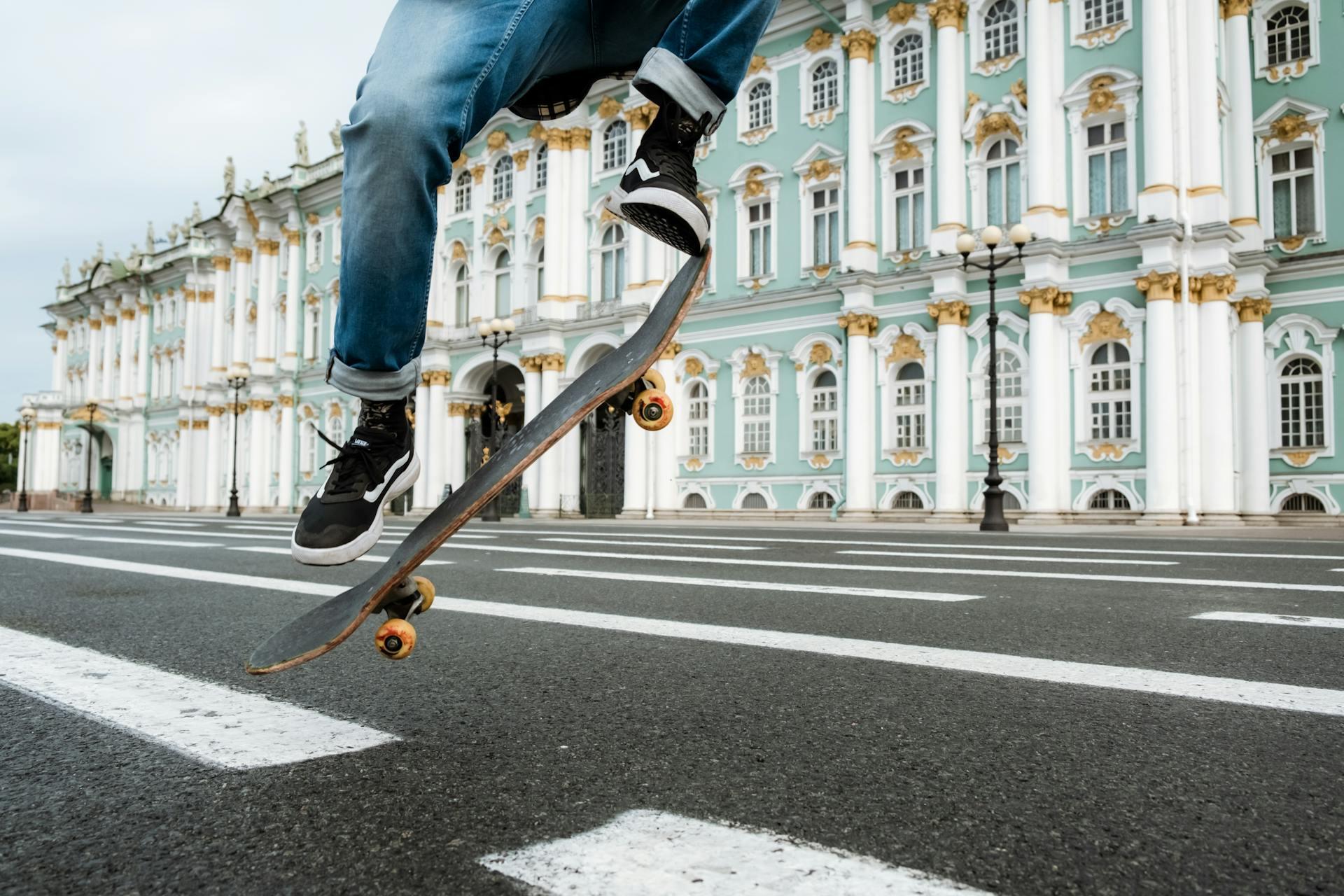
What Does Cruising on a Skateboard Mean?
Cruising is just what it sounds like: coasting along and enjoying the view. Many skaters like to cruise on a longboard skateboard or an electric skateboard, especially for long rides. Sometimes these rides are purely recreational and sometimes they’re part of a commute to work, the route to an errand, or a mode of transportation to another activity.
No matter which type of skateboarding appeals to you, you still need to know the aforementioned foundations and wear safety gear.
A List of Basic Skateboard Terms
Feeling a little overwhelmed with all the different skateboarding terms? Here is a quick glossary to refresh your memory.
| Term | Meaning |
|---|---|
| Bolts | The 4 visible bits of mounting hardware on the deck located just before the nose and tail |
| Carving | When you press into your heels or toes to steer the board |
| Concave | The part of the deck that curves upward |
| Coping | The metal tube edge on top of a half pipe or ramp |
| Cruising | Skating over long distances with little to no tricks |
| Deck | The part of the skateboard you stand on |
| Fakie | Going backwards on your board (not to be confused with switch or goofy) |
| Foot braking | When you drag the sole of your shoe on the ground to stop |
| Goofy stance | When the left foot is the front foot in your stance |
| Grip tape | The sandpaper-like material on top of the deck |
| Kickflip | When you kick the board while doing an ollie so it spins in the air |
| Kickturn | When you lift the nose and redirect the board to the left or right |
| Manual | Lifting the nose and on the back wheels only |
| Mongo | Pushing with the front foot |
| Nose | The front of the skateboard |
| Ollie | Jumping with the board following your feet into the air |
| Pushing | Propelling the skateboard forward with your foot |
| Switch | The opposite stance of your normal stance |
| Tail | The back of the skateboard |
| Tail stop | When you press on the tail to scrape it against the ground to stop |
| Tic-tac | When you qucikly lift the nose and change direction by turning your body |
| Trucks | The hardware containing the axles connecting the wheels to the deck |
Where to Learn How to Skate
Finding out where and how to start skateboarding in the first place is just as important as learning how to learn to skateboard. You’ve got your gear, your board, and a good idea of how you want to start practicing, but how can you actually go out there and begin?
Here are a few options of places and ways you can start spending time on your skateboard.
- Skateparks: Skateparks are designed specifically for skateboarding enthusiasts. Many skateparks also offer skateboard lessons near me led by experienced skaters.
- Local Skate Shops: Skate shops are a hub for gear, connections, and knowledge. Many shops host regular events where experienced skaters volunteer as skateboarding guides for newcomers.
- Skate Camps and Clinics: These intensive programs provide hands-on instruction, personalized feedback, and a supportive community of fellow learners.
- Skateboarding Coach: With a professional skateboard instructor from Superprof, you can find skateboard classes near me via online or in-person lessons with an experienced skater!
Now that you know the basics of skateboarding, what tricks you can learn early on, and resources for getting personalized instruction, you’re more than ready to begin your journey into skateboarding! Buckle your helmet and get ready to start skating!

